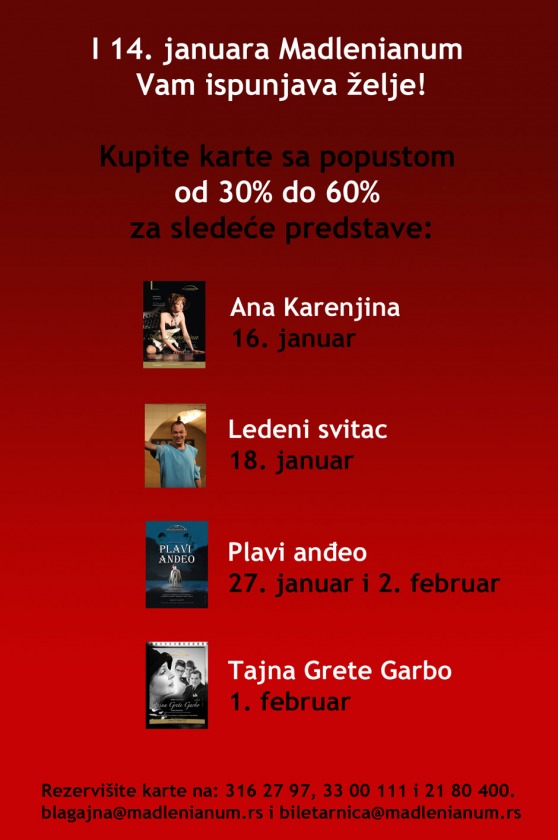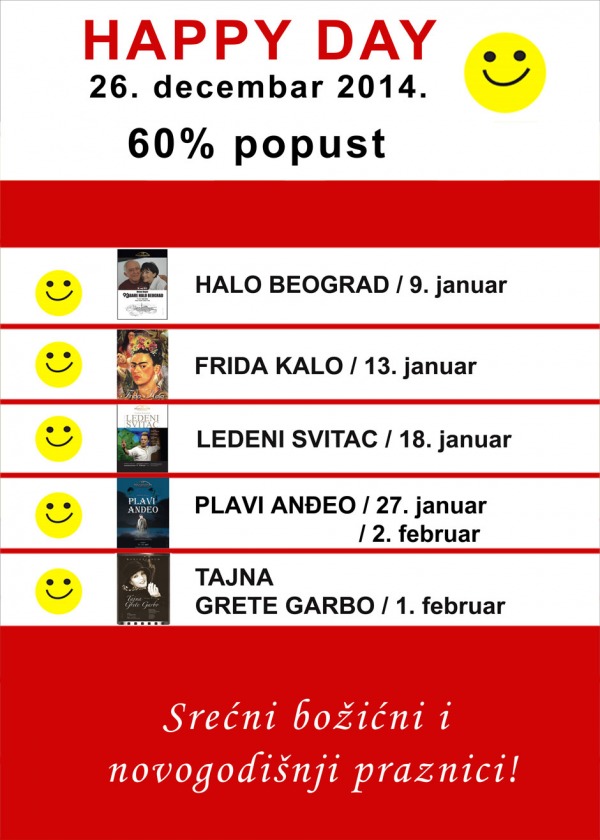14. januara
popust od 30 do 60%




U petak, 26. decembra, u Zepter hotelu održana je završna konferencija za medije u ovoj godini. Najavili smo projekte koji nas čekaju do kraja 2015. godine, pre svega muzički komad "Male tajne" i dramu "Miloš Crnjanski".
MALE TAJNE
Komad sa glumom, pevanjem i plesom
Tekst i režija: Goran Marković
Muzika: Zoran Simjanović
Koreografija: Mirko Knežević
Scenografija: Nebojša Bradić
Kostim: Dragana Ognjenović
U 2015. godini kao svoju prvu premijeru Opera i teatar Madlenianum najavljuje predstavu „Male tajne“ za koju je tekst pisao i režira ga Goran Marković. Naročito nas raduje saradnja sa našim poznatim filmskim i pozorišnim rediteljem Goranom Markovićem, koji je za prvu saradnju sa našom kućom izabrao intimno delo o glumačkim počecima svojih roditelja. Važno je istaći da je ovo prvi muzički komad, na originalnu muziku Zorana Simjanovića, koji Marković režira u pozorištu.
Predmet interesovanja ovog komada je pozorišna družina, dramska grupa koja je stvarno postojala, nastala pred Drugi svetski rat, delovala tokom rata i posle njega, bila pokretačka snaga Beogradskog Dramskog Pozorišta u njegovim slavnim godinama i raspala se pred kraj pedestih, neposredno pošto je učestvovala u rađanju jednog novog teatra – Ateljea 212. Mi ćemo pratiti nastanak ove družine, njen razvoj i vrhunac, i najzad se, kada ona prestane da postoji, oprostiti od nje.
„Ova priča će, dakle, biti zasnovana na istinitim zbivanjima, ali će, u isto vreme, biti pomešana sa mnoštvom izmišljenih događaja. Pošto ćemo na taj način faktografiju pomešati sa fikcijom, junaci ovog komada neće biti stvarne ličnosti. Iako su nam uzori bili imena koje su zaista postojala većina likova će do te mere biti modifikovana i pomešana sa stvarima koji su produkt mašte da se ne može govoriti o istorijskoj verodostojnosti“, ističe reditelj.
Način na koji ćemo ispričati ovu hroniku primeren je dramskoj formi: bavićemo se pojedinačnim sudbinama njenih aktera ali ćemo istovremeno posmatrati šta se dešava sa društvom kroz taj dvadesetogodišnji period. Naravno, nas će interesovati i fenomen samog pozorišta, glume i odnos vlasti prema toj umetnosti. Ali, u prvom planu biće glumci, njihovi životi, umetnički razvoj, intima, ljubavne peripetije i sve ono što čini život iza pozorišne zavese. Pored glavnih junaka, članova pozorišne družine, tu je još mnoštvo važnih likova, od mecene, preko učitelja glume, nemačkih okupatora i drugih…
Paralelno sa razvojem priče, događaje će pratiti šlageri iz epohe. Možda je važno napomenuti da će “Male tajne” ujedno biti i svojevrsna retrospektiva zabavne muzike u periodu od 1939, kada naša priča počinje, za vreme rata i nemačke okupacije, pa sve do 1958, kada se serija završava. Muzičke tačke će biti inkorporirane u priču ali će istovremeno biti i numere za sebe.
Glavna uloga u ovom komadu je poverena doajenu našeg glumišta Predragu Ejdusu, dok će ostale uloge biti izabrane na audicijama koje su održane 17. i 18. decembra, i na audiciji koja se održava 26. decembra. Premijera komada je planirana za 27. mart 2015. dok će prva repriza biti 03. aprila.
MILOŠ CRNJANSKI
Dramatizacija: Slavenka Milovanović
Koautor teksta i režija: Ivana Vujić
Scenografija i kostim: Kosta Bunuševac
Muzika: Irena Popović
Koreografija: Isidora Stanišić
Video: Svetlana Volic
Opera i teatar Madlenianum od samog osnivanja dramske scene pre deset godina redovno neguje repertoar koji je tematski obeležen životima i delima velikih istorijskih ličnosti iz sveta umetnosti i nauke. Premijere koje su bile biografske započele su predstavom o Nikoli Tesli, usledio je ciklus drama o slikarima El Greku, Fridi Kalo i Salvadoru Daliju. Upriličen je i omaž glumici Greti Garbo predstavom o njoj. Poslednja iz ciklusa biografskih predstava bila je drama o srpskom naučniku Milutinu Milankoviću. Dramski tekst o Nikoli Tesli nastao je iz pera Miloša Crnjanskog i upravo je Miloš Crnjanski stvaralac čijim životom će se baviti premijera u Madlenianumu na Velikoj sceni.
Miloš Crnjanski nesumnjivo spada u mali broj pisaca koji se ubrajaju u sam vrh srpske književnosti. Dela koje je stvorio njegov potpuno autentičan talenat iz oblasti romana, poezije, drame i eseistike vreme samo potvrđuje kao remek dela kojima se srpski narod mora ponositi. Miloš Crnjanski kroz svoja dela, ali i kroz svoju životnu priču često punu osporavanja i teškoća, svakako mora biti ličnost koja će se predstaviti mlađim generacijama u našoj zemlji. Izuzetno važno bi bilo da Evropa i svet znaju za vrednosti srpske kulture koje dobijamo kroz dela ovog velikog pisca, svetskog čoveka koji se pored književnosti u jednom periodu svog života bavio i diplomatijom.
U predstavi o Milošu Crnjanskom glavno težište biće stavljeno na period izgnanstva Crnjanskog i njegove žene Vide za vreme i posle drugog svetskog rata, a potom i na njihov željeni povratak u Beograd. Kroz taj pozniji period života Miloša i Vide Crnjanski preplitaće se njihova sećanja na detinjstvo i dane mladosti.
Dramski tekst „Crnjanski“ nastao je kao koautorsko delo Slavenke Milovanović i Ivane Vujić koja će i režirati ovu značajnu predstavu. Vrhunski umetnik Kosta Bunuševac biće zadužen za vizuelni identitet predstave, za scenografiju i kostime.
Delo se radi u koprodukciji sa Bitef festivalom i teatrom, a biće napravljena i saradnja Fakulteta dramskih umetnosti iz Beograda i Akademije umetnosti iz Novog Sada, čiji studenti će učestvovati u komadu. Premijera predstave sa velikim glumačkim zvezdama o Crnjanskom, književniku čijem se delu treba klanjati, planira se za otvaranje sezone 2015/2016.
Choreography, music: Hofesh Shechter
Sets design: Merle Hensel
Costume design: Christina Cunningham
Lighting design: Lee Curran


EVENT Group vam predstavlja Robija Lakatoša i Gyass Bend!
28. novembra 2014. u 19:30 sati u teatru Madlenijanum u Zemunu
Šta povezuje mađarsku cigansku muziku, klasičnu muziku i džez, uz dar za improvizaciju?
Robi Lakatoš i Gyass bend, naravno!
Robi je violinista koji prevazilazi svako poređenje i definiciju.
Dar koji je stekao od predaka kroz sedam generacija, ponovo će podeliti sa nama.
Opustite se uz jedinstvenu energiju kojom zrači tokom njegovih koncerata i saznajte zašto ga zovu „vragolasti violinista“ - najbrži od svih brzih maestara na violini. Uživajte u svetu muzičke slobode, snage i topline uz poznate i zaboravljene melodije, obučene u nove i zavodljive, originalne muzičke aranžmane.
ROBI LAKATOŠ (ROBY LAKATOS) je virtuoz na violini koji kombinuje različite muzičke stilove. Kod njega ćete čuti klasičnu muziku ili džez u kombinaciji sa narodnom mađarskom romskom muzikom. On prevazilazi stilove i definicije, jer kreira nešto novo i drugačije. On je improvizator i kompozitor, retka pojava našeg doba, koja stvara sopstveni muzički stil.
Rodjen je 1965. godine u porodici mađarskih Cigana violinista koji vode poreklo od Janoša Biharija, „kralja ciganskih violinista“ čije su kompozicije koristili List i Betoven. Violinu svira od detinjstava, a prvi nastup imao je sa devet godina. Razvijao se kao muzičar u okviru svoje porodice i na Konzervatorijumu „Bela Bartok“ u Budimpešti, gde je 1984. osvojio prvu nagradu za izvođenje klasične muzike. Njegov dom je od 1986. u Briselu gde je do 1996. sa svojim ansamblom zabavljao slušaoce u „Les Ateliers de la Grande Ille“. Sarađivao je sa Vadimom Repinom i Stefanom Grapelijem, a njegovu muziku u Briselu je čuo i možda najbolji violinista 20.veka Jehudi Menjuhin. Svirao je sa Londonskim simfonijskim orkestrom, u sidnejskoj Operi ali i sa nekim od najvećih džez muzičara našeg doba kao što su Herbi Henkok i Kvinsi Džons.
Robi Lakatoš nije stranac u Srbiji. U januaru 2014. svirao je na Kolarcu sa Gudačima Sv. Đorđa i „Đas (Gyass) bendom” iz Subotice. „GYASS BAND” (na romskom „idemo!”) postoji već deset godina i sa Lakatošem svira obrade klasičnih, džez, ciganskih numera, srpskih narodnih kola.
Na koncertu sa Robijem Lakatošom u pozorištu “Madlenijanum“ u Glavnoj ulici u Zemunu, 28. novembra u 19:30 sati „Gyass band“ predstaviće i svoj novi CD, muziku sa našeg područja koja je puna emocija i kreativnosti. Sa njima svira i Laslo Boni, druga violina u stalnom pratećem ansamblu Lakatoša. Boni je učenik Robijevog oca, kao veteran brojnih turneja od Japana preko Evrope i Amerike, stiže i u našu koncertnu dvoranu „Madlenijanum“.
U cenu ulaznice je uključena i čaša vrhunskog vina koje će biti posluženo u 19:30 sati u foajeu Madlenijanuma. Koncert će početi u 20h.
„Da je violinista Robi Lakatoš plaćen po broju nota koje odsvira tokom svog koncerta, verovatno bi bio najbogatiji muzičar na svetu.“ – Los Anđeles Tajms
Zahtev za kupovinom ulaznica za ložu: 063 106 2836 ili 011 32 32 531
Tekstovi iz stranih medija:
http://www.medici.tv/#!/roby-lakatos-interview-verbier2011
http://www.connectsavannah.com/savannah/review-roby-lakatos-lucas-theatre/Content?oid=2132638
Linkovi sa numerama:
http://www.youtube.com/watch?v=1edPenNyGfI
EVENT Group vam predstavlja Robija Lakatoša i Gyass Bend!
28. novembra 2014. u 19:30 sati u teatru Madlenijanum u Zemunu
Šta povezuje mađarsku cigansku muziku, klasičnu muziku i džez, uz dar za improvizaciju?
Robi Lakatoš i Gyass bend, naravno!
Dramatization Milica Konstatinovic
Directing Boris Todorovic
Choreography Milos Sofrenovic
Composer Janja Loncar
Set Design Milica Stankovic
Assistant Set Designer Marija Timotic
Costume Designer Aleksandar Kovacevic
Lector Olga Marinkovic
CHARACTERS
Robert Syverten................................. Andrija Danicic
Gloria Beatty....................................... Violeta Goldman
James Bates....................................... Stevan Piale
Ruby Bates.......................................... Lidija Cvetic
Joel Gerard......................................... Milos Milic
Alice Tomplin.........................................Iskra Brajovic
Rocky Gravo..........................................Radomir Nikolic
Rollo Pitters...........................................Sasa Joksimovic
Mrs. Laydon...........................................Dragica Ristanovic
Stage Manager: Ana Prokic
Organizer: Vlastimir Repic
Stage Master: Milan Ciric
Audio Realization: Dusan Arskin
Lighting Realization: Vladimir Krunic
Video Realization Zvonimir Jelusic
Make-up and Hairstyle: Mirjana Rakic
Wardrobe: Tanja Vuksanovic and Miladin Pavicevic
Workshop equipment realization: Opera and Theatre Madlenianum
Preparing for the new performance has begun in the Opera and Theatre “Madlenianum”. The word is about a drama-dancing project, “They Shoot Horses, Don’t They” and the audience will be able to see the premiere of it on 28th November (the first revival is on 2nd December). This interesting project of the young team of authors, led by a playwright Milica Konstantinovic, a director Boris Todorovic and a choreographer Milos Sofrenovic, is the winner on the competition of the Young theater creators that was for the first time opened in Madlenianum in February this year. The members of the team of authors are also Janja Loncar- a composer, Milica Stankovic- a set designer and Aleksandar Kovacevic- a costume designer.
The acting ensemble is formed in June, after a four-day audition and it consists of Violeta Goldman, Andrija Danicic, Stevan Piale, Lidija Cvetic, Milos Milic, Iskra Brajovic, Radomir Nikolic, Sasa Joksimovic and Dragica Ristanovic.
Drama template for the performance “They Shoot Horses, Don’t They?” is based on the same named novel by Horace McCoy from 1935. The theme of the novel is a dance marathon which was popular in that period. The winner of the marathon would get prize money, which meant that a couple had to endure for about 2500 hours of continuous dancing. During those marathons in suburbs of Hollywood, where people were completely dehumanized, Ginger Rogers and Fred Aster “were dancing beneath the stars while the magic of Hollywood was glowing in their eyes, waking up all the false promises”.
The Director of the performance Boris Todorovic says: “We are not as incorruptible as we think and that is why one should be cautious in preserving humanity in crisis, because future generations shall judge us, not by how we acted when things were going well, but how we treated each other when they weren’t”. During the rehearsals of the ensemble, which sparkles with the whirling strength, positive energy and imagination, Boris Todorovic together with his associates creates a theatrical essay that is certainly to concern a contemporary viewer, since social depression, described by Horace McCay in his legendary novel unfortunately, has still many familiarities with the reality we live in. The play does not give an answer to the question who won in a dance marathon. It offers viewers an opportunity to see the light the losers shine with.